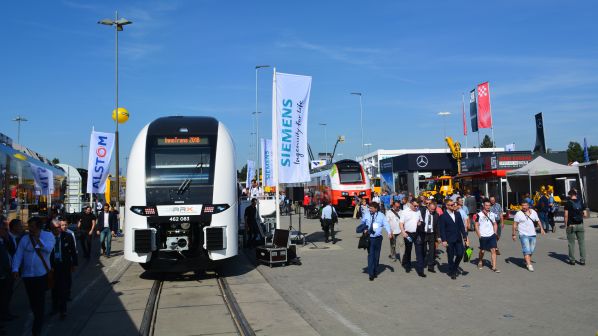INNOTRANS once again lived up to its billing as the largest railway industry exhibition in the world with record numbers of visitors
attending the 2018 event, which was held at Messe Berlin from September 18 to 21.
In total, 161,157 attendees from 149 countries visited 3062 exhibitors hailing from 61 countries. This was up from the 145,000 visitors and 2955 exhibitors which attended the 2016 event where attendance had also increased by 4%. In addition, more than 400 innovations, including 155 world premieres, were shown while 145 vehicles were on display at the 3.5km outside track area.
Around 52% of trade visitors came from outside of Germany, with numbers from southern, eastern and central Asia experiencing the highest growth. In addition, 25 business delegations from 18 countries, including from Abu Dhabi, India and the United States, visited the exhibition.
A representative survey conducted by Messe Berlin found that 50% of those polled occupied a senior position in their company, and around 89% of exhibitors said they were satisfied with their results at the trade fair.
“This year’s InnoTrans once again impressively showed that it is the ideal platform for presenting forward-looking innovations, combined with an enormous international appeal,” says Messe Berlin CEO, Dr Christian Göke. “No other event offers trade visitors such a comprehensive and global insight into every part of the industry’s value chain.”
The core halls 1-6 and the infrastructure halls 25 and 26 were extremely busy throughout the exhibition, although traffic, as it usually is, was noticeably much reduced on Friday.
Attention will now slowly shift to 2020. With Messe Berlin reporting that it turned away prospective exhibitors, the organiser is on the verge of expanding the exhibition space. With cranes looming overhead, Hall 27 - “The Hub” - appeared close to completion during this year’s event.
Although the location overlooking the line-up of new trains and rail vehicles is disappointing for photgraphers, compared with the outlying CityCube, the last major addition to the exhibition centre, which opened for the 2014 edition, the location adjacent to Hall 2 and the outside track area appears favourable.
As InnoTrans enters the 2020s, the sector’s appetite for the biannual event seems to show no signs of waning. And with more exhibitors expected, it is very likely that attendance will continue to grow when the railway world returns to Berlin in two years’ time.
Rail can be a leader, says commissioner Bulc
THE European Union’s (EU) transport commissioner, Ms Violeta Bulc, officially opened InnoTrans 2018 in Berlin on September 18, and she said that “at the dawn of the fourth industrial revolution we have a chance to lead that revolution.”
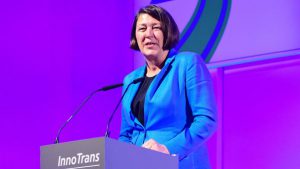
Referring to the publication of the European Union’s rail passenger satisfaction survey, Bulc says in almost all areas the results are better than in the previous survey in 2013.
She notes that 80% of Europeans take the train at least once a year, and 13% are regular travellers. 75% of rail passengers agree buying tickets is easier than before, and 60% are satisfied with the level of frequency, which is an improvement over the situation five years ago. 59% of passengers are satisfied with the level of punctuality.
“Only 38% of passengers are satisfied with the handling of complaints, and there has been little improvement,” Bulc says. “Accessibility for disabled passengers is still problematic, especially regarding station staff. I am calling on all CEOs to improve this in the next five years.”
“The survey also shows the need to make the integration of modes better,” Bulc says. “Investment to improve the last mile to and from the station is really essential. Please join forces with other operators to improve this.”
Bulc outlined three key points to which she believes Europe’s railways need to pay special attention:
- better cooperation - on a digital level it is all about the user’s needs
- multi-modality, and
- infrastructure - the new EU Multiannual Financial Framework for the 2021-2027 budgetary period will have an investment fund of e36bn.
“Next year, the rationalisation of all railway rules will be completed thanks to the work of the EU Agency for Railways so we can finally have a single market for rail in Europe,” Bulc revealed.
“Regarding ERTMS, I want you to take this seriously,” she urged CEOs. “It hasn’t really hit the market yet in Europe, while railways around the world are embracing it. I want to see a full-scale deployment of ERTMS in Europe - it will be a huge benefit.
“The future of mobility is clean, silent, efficient, and above-all customer oriented. If we can achieve this, the future will be really bright.”
Siemens and DB to cooperate on Ideas Train
SIEMENS Mobility and German Rail (DB) signed a cooperation agreement on September 20 at InnoTrans to collaborate on the Ideas Train, a project to develop and showcase ideas for the future of passenger rail.
The agreement was signed by the member of the management board of DB for digitalisation and technology, Dr Sabina Jeschke, chairman of the management board of DB Regio, Dr Jörg Sandvoss, and Siemens Mobility CEO, Ms Sabrina Soussan.
The agreement makes the Ideas Train available as a platform for partners in the vehicle industry to test components and prototypes, with Siemens Mobility the first system manufacturer to sign up. The companies say the partnership aims to merge their components and develop the platform to create a travel experience with digital features that is designed to meet passenger needs.
“With the Ideas Train we are making a substantial contribution in the research and development of vehicles for the passenger transport of the future,” Jeschke says.
The Ideas Train already features the first prototype from Siemens, an active noise cancelling system in the “power napping” module which reduces noise from wind, HVAC-systems, and bogies to allow passengers to rest more easily. Silentium, Israel, is providing support to Siemens for the system.
The smart seat, which was built in collaboration with Polish-based Taps, offers a number of digital services including ticket purchase and check-in with an integrated touchscreen. Passengers can also order food and drinks from the on-board restaurant, listen to music and watch movies as well as customise the seat position and save the settings in the cloud using Siemens MindSphere. If they change trains and log in again, their movie picks up where they left off.
The Ideas Train also features “my cabin,” a premium seat aimed at business customers, which features a window that can be frosted at the push of a button for privacy, a large screen that can be connected to a laptop, and an ergonomic, adjustable chair.
Stadler and HVLE unveil bi-mode loco
STADLER and Havellian Railway (HVLE) unveiled a new generation of six-axle, bi-mode Eurodual locomotives at InnoTrans. The CoCo Eurodual, which has a maximum speed of 120km/h, can be powered from either a 2.8MW diesel engine or up to 7MW under electric power, and is designed for a supply voltage of both 25kV 50Hz and 15kV 16.7Hz.
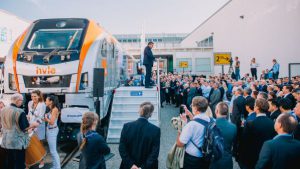
HVLE ordered 10 Eurodual locomotives in 2017, becoming the launch customer for the new platform. Two locomotives have commenced certification tests in Germany, and are due to enter service next year.
Mr Iñigo Parra, CEO of Stadler Valencia, the division which designed and built the locomotive, told IRJ that the certification process is underway in three other European countries, while further orders are in the pipeline.
DTI to supply PIS for South African EMUs
DTI, Australia, has finalised contract negotiations with Alstom Ubunye for the supply of Passenger Information Systems (PIS) for the 576 X’Trapolis EMUs which Alstom is supplying to Passenger Rail Agency of South Africa (Prasa).
Each train will feature side, front and internal displays on each coach which will use DTI technology. Manufacturing of the trains is underway at the Gibela consortium’s plant in South Africa.
The PIS contract, valued at $A 19.1m ($US 13.8m), was announced to the Australian Securities Exchange as a Letter of Intent on June 12 2017. Delivery of the systems will commence in December 2018 and will be supplied over 10 years until 2028. After an initial ramp-up, DTI is expecting to deliver around 60 sets each year.
The contract was formally signed at InnoTrans in Berlin with representatives from DTI, Alstom, Austrade and the Australasian Railway Association in attendance.
CRRC unveils carbon fibre metro car
CRRC’s Next Generation metro train, Cetrovo, a project of its joint venture with CG Rail, Germany, was unveiled at the outside track area and garnered significant attention throughout the show.
The single car on display consists of around 70% carbon fibre structures, which offer a 13-14% weight reduction compared with a conventional metro vehicle.
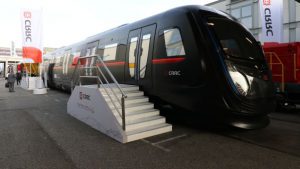
Major carbon fibre components include the driver’s cab, equipment cabinets, car body, bogie frame and the pantograph. The train also utilises permanent magnet synchronous motors, silicon carbide converters and emergency batteries with a range of up to 15km.
According to Mr Jingie He, head of the international cooperation department at CRRC, two further cars are undergoing tests at a test track in China. Jingie confirmed that the European car would undergo static tests at a European facility following the show.
Jingie says that the cost of the carbon fibre structures, which are around double those used in a conventional metro vehicle, actually makes the material more suitable for future application in a high-speed EMU or a maglev vehicle rather than a metro train. He said these applications are more likely as these operators are willing to invest in more expensive materials.
New leasing company focuses on hybrid traction
DETAILS of a new European locomotive leasing company focussing on hybrid traction were announced at InnoTrans on September 18.
Based in Frauenfeld, Switzerland, European Lok Pool (ELP) is a partnership between Swiss firm PCS Holding and Lucerne-based bank Reichmuth.
ELP says market demand for full-service leasing is increasing, and the company’s leasing package reflects this trend. ELP will offer the complete management and maintenance of locomotives as part of the leasing rate, with a service package including preventative and corrective maintenance as well as examinations and repairs. Servicing covers the entire lifecycle of the locomotive.
ELP’s first order is for 10 Stadler EuroDual locomotives, with the first due for delivery in the second half of 2019. The company also plans to add four-axle bi-mode shunting locomotives to its portfolio.
Train planning software enables real-time response
HACON demonstrated its TPS Online timetable planning solution, which has been developed specifically to optimise ad hoc train dispatching in the event of operational disruption.
TPS Online detects conflicts that affect the performance of the overall network and offers automatic, semi-automatic and manual resolution.
The solution also supports migration to Automatic Train Operation (ATO) by providing ATO trackside target times to ATO onboard units using dynamically-calculated train forecasts based on real-time data.
Finnish infrastructure manager Liikennevirasto is one of the first customers for TPS Online.
Fraunhofer shows drone inspection system: An eye-catching exhibit on German research institute Fraunhofer’s stand was a drone-based line and asset inspection system. The drone is designed to fly over lines to check for possible infringements and is fitted with two 8-megapixel cameras and a radar system. The drone can process images covering up to 100m2 in 10 minutes. This information is stored on a hard drive, with a USB port available for data retrieval. The system is able to record three-dimensional data which is transferrable to a two-dimensional map, enabling infrastructure managers to remotely identify the precise location of objects in the real-world. Fraunhofer says the system is already in use with Strabag to monitor construction sites. It can also support the development of BIM databases.
Doppelbauer: quick wins needed to boost rail freight
JOSEF Doppelbauer, executive director of the EU Agency for Railways, hosted a lively debate on the future of European rail freight.
Mr Frank Andreesen from Covestro, a polymer manufacturer and freight shippers bemoaned the fact that rail freight suffers from too many national systems and called for some quick wins to improve cross-border rail freight:
- introduce a common language for train drivers
- abolish the second driver on freight trains in Italy and retrain them as full drivers to help plug the shortage of train drivers in Europe
- improve European infrastructure planning to speed up investment, and
- give more power to rail corridor managers to overcome national conflicts.
This was backed up by Mr Libor Lochman, executive director of the Community of European Railways and Infrastructure Managers (CER). “We need an upgrade of the infrastructure to create the single European railway - there is a huge range of tasks which the sector has to do,” he said. “We need open borders, and more automation by 2030.”
“My concern is that we continue to run into severe bottlenecks, which are close to collapse,” Andreesen added. “We already have collapses on parts of the rail and road networks each week, and things seem to be getting worse. People don’t seem to recognise what bad shape our infrastructure is in.”
“The capacity crunch could be much worse in 10 years’ time,” Mr Henrik Hololei, the European Commission’s director general for mobility and transport, said. “Operators and logistics managers can push national railways to make things happen. We could have been more ambitious with the Fourth Railway Package, but let’s deliver it and not find ways to delay it.”
On a brighter note, Doppelbauer said that there has been a significant cut in national rules in EU member states from around 14,000 in January 2016
“For the 19 countries that have cleaned up their rules, there were only 900 remaining by June 2018,” Doppelbauer said. “The highest number of national rules is 100 in Italy.
“We have already achieved a shift in the balance between national and EU rules, and we will reach 1200 rules for all 27 countries.”
First Berlin S-Bahn half-train presented
THE first-completed class 484 half set for the Berlin S-Bahn was presented to Mr Christian Gaebler, head of Berlin’s Office of the Senate, Mrs Susanne Henkel, managing director of Berlin-Brandenburg transport authority VBB, and Mr Peter Buchner, CEO of DB Regio subsidiary S-Bahn Berlin, by Siemens Mobility CEO, Mrs Sabrina Soussan, and Stadler Pankow CEO, Mr Ulf Braker, on September 18.
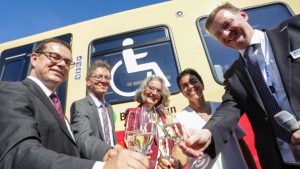
In December 2015 S-Bahn Berlin awarded Stadler and Siemens a framework contract to supply up to 1380 vehicles, with the initial order for 106 trains comprising 85 four-car class 484 and 21 two-car class 483 sets.
The first 10 trains will enter service on Line S47 from Südkreuz to Spindlersfeld in January 2021.
GE wins Turkish PowerHaul order
GE Transportation announced a contract to supply five of its PH ‘PowerHaul’ diesel locomotives to Turkish private operator Korfez Ulastirma, the rail freight subsidiary of Tüpras, Turkey’s largest oil refining company, which is responsible for moving oil products between the company’s refineries.
This is the first order placed by a Turkish private rail operator since the deregulation of the market which enabled open access operation from 2017.
GE and its Turkish partner engineering firm Tülomsas will build the locomotives in Eskisehir, Turkey, using components supplied by GE Transportation. The GE PowerHaul PH37ACi design is equipped with a 16-cylinder 2.76MW GE PowerHaul P616 engine and is compliant with EU Stage IIIa emissions plus TSI interoperability standards.
MTU secures hybrid powerpack customers
THE CEO of rolling stock leasing company Porterbrook, Mrs Mary Grant, and Rolls Royce vice-president for industrial business, Mr Lars Kraft, signed an MoU at InnoTrans on September 19 for the delivery of MTU Hybrid Powerpacks for tests on two class 170 Turbostar DMUs in use in Britain.
The two companies are expected to sign the formal supply agreement by the end of the year with tests due to conclude in 2020, and commercial availability expected in 2021.
The conversion project will upgrade current diesel engines to comply with EU Stage V emissions standards, providing a 70% reduction in NOx emissions and a 90% cut in particulates while the trains will offer emission-free operation when entering and leaving stations.
MTU also signed an agreement with Abellio Rail Mitteldeutschland, Alstom, and Saxony-Anhalt public transport authority to implement hybrid powerpacks on a fleet of 54 Coradia Lint DMUs used on the Saxony-Anhalt Diesel Network.
The partners plan to sign a contract to retrofit three vehicles once this feasibility study concludes.
Vossloh and Frauscher present track monitoring system
VOSSLOH and Frauscher unveiled their joint Continuous Track Controlling project, which is based on Distributed Acoustic Sensing technology.
The system promises to enhance maintenance of the complete railway track structure by offering early detection of problems with rails, rail joints, sleepers, and fastenings as well as weak points in the ballast and substructure.
DAS uses fibre optic cables to detect vibration signatures created by continuous monitoring of the wheel-rail interface and by noting any changes in the reflection of laser pulses. Any deviation from stored standard parameters indicates an anomaly and the start of weak spots on the track.
The objective of the Vossloh-Frauscher project is to develop a maintenance management system based on information held in a database in order to provide infrastructure managers with an early detection system for possible infrastructure issues.
New modular wagon prototype on show
RAIL Cargo Wagon, a subsidiary of Austrian Federal Railways (ÖBB), exhibited Transant, a new modular wagon concept developed in partnership with Voestalpine, at the outside track area.
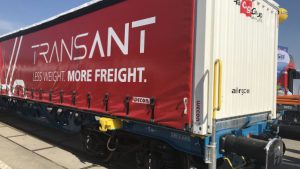
The 21m-long wagon is 20% lighter than an equivalent vehicle and as a result can offer a 4-tonne increase in payload. The wagon’s underframe, is responsible for reducing the weight. It utilises a high-strength but lightweight L-form grade 550 and 700 steel provided by Voestalpine, which is 1cm thick compared with 2cm in a conventional wagon. Cutting of the steel and manufacturing of the wagon was conducted by the TS Slovakia joint venture of ÖBB Tech Service and Zos Trnava.
The wagon also offers central buffer coupling making it suitable for single-wagon operation while it can also be hump shunted. The developers worked with Wacon, a supplier of tarpaulins for trucks, to develop a similar system for rail. This improves the flexibility of loading with users able to open the roof for 17m of the 21m length of the wagon.
Rail Cargo Wagon executive director, Mr Andreas Redling, told IRJ that developing a wagon comparable or cheaper than existing freight vehicles was critical to the project.
Redling said 14 prototypes have been manufactured as part of the pre-series project and he expects operation with the new wagons to begin by the end of the year, and completion of the initial project with Voestalpine consisting of 30 wagons in 2019. The wagon will be available commercially from 2021, although Redling admits it is unlikely that Rail Cargo Wagon will become a wagon manufacturer.
Thales’ Lucy demonstrates ETCS Level 3
AT the outside track area, Thales exhibited Lucy, an ETCS Level 3 test train which recently completed trials with a Bombardier Traxx test locomotive at DB Netz’s Living Lab in Saxony
The NE 81 train from the early 1980s was equipped with Thales’ onboard unit. It was connected over the cloud to the supplier’s Radio Block Centre in Berlin and successfully demonstrated the use of virtual block technology. Lucy also uses Thales’ thermal imaging and laser sensor technology, which the supplier says could form the foundation of future autonomous driving technology.
Thales says that using a legacy train demonstrates the system’s compatability with all rolling stock.
Inside, a highlight exhibit was the premiere of Lite4ce, a smart fibre-optical track sensor, which is able to eliminate the perturbations found in electromagnetic sensors, resulting in less maintenance, operation issues, and improved fault detection.
As a passive sensor, all electrical equipment is located away from the track allowing maintenance staff to monitor and carry out maintenance without affecting operation. Thales has also developed a system that “glues” the sensor to the track, allowing quicker installations.
Germany backs rail to meet climate change goals
GERMANY’s federal minister of transport and digital infrastructure, Mr Andreas Scheuer, told the opening ceremony that Germany is increasing its commitment to rail.
“We are looking at some major investments in the future, and rail has priority but there are a lot of challenges,” Scheuer says. “Building rail is expensive and takes a long time, but rail is extremely state-of-the-art. However, we must ensure that citizens are involved at an early stage.
“We want to support rail to help meet our climate change goals. We are reducing noise emissions and encouraging digitalisation.
“Our German national regular-interval timetable project will facilitate interchange between services and release more tracks for freight. It is a mammoth project and a huge step forward to enhance quality.
“Our 2030 infrastructure plan calls for an investment of €270bn of which around 40% is for rail. This will enable Germany to make a huge commitment to the continent. Of course it will take time to develop projects, and we have an acceleration programme before parliament. ETCS will increase capacity on the rail network by 20% without a single piece of new track,
and 70% of the network will
be electrified.”
“Digitalisation is the most important element in the master plan. Innovations will guarantee the future of rail. This year, for the first time, we want to have a new rail research programme covering things such as noise reduction and battery-charged trains. We want lower emissions and even to become emission-free by 2030.”
Rail can be a winner of the Fourth Industrial Revolution
GERMAN Rail (DB) hosted an afternoon of high-level debate and presentations during the third afternoon of InnoTrans at the DB Innovation Forum, which addressed the theme of shaping intermodal mobility together.
In her keynote address, professor Ms Sabina Jeschke, DB’s board member for digitalisation and technology, set the scene for the debate by outlining the four major challenges she said DB faces: capacity, complexity, human resources and speed of innovation.
Jeschke was keen to stress that the fourth industrial revolution can benefit DB and help the railway to thrive in the 21st century by solving many of its underlying issues.
For example, new intelligent technologies and systems based on AI can solve maintenance problems, which are responsible for 50% of DB’s quality issues. New technologies can also help to overcome the problem of capacity without expensive and time-consuming investments in new infrastructure.
To take advantage, Jeschke called on DB to come up with new data strategies. She said DB currently has 2500 databases, most of which are separate with limited sharing or interaction taking place. Instead she said DB should adopt a “data lakes” strategy, pioneered by companies such as Facebook and Google, to use and bring data together in a data loop.
Jeschke concluded her address by reflecting on new developments in computing and the end of the era of Moore’s law, which she said has defined computing for the past 40 years. Quantum computing promises to open new opportunities for industry and Jeschke said it is her dream to utilise this technology to create a “digital twin” of DB. “This will enable us to test and prove new technologies and come up with realistic solutions to complex problems,” she said.
Also addressing the innovation challenges the sector is facing, Dr Josef Doppelbauer, executive director of the European Union Agency for Railways, said that the emphasis should be on “soft innovation” and securing quick wins with existing infrastructure to overcome rail’s typical 25-year innovation cycle.
He said that while the sector has great ideas and innovations, epitomised by the solutions on show at the vast exhibition, fragmentation and an absence of global rules is holding the industry back from achieving its potential.
Doppelbauer argued that rail should “mainstream” its approach to innovation, emphasising seven points as critical to success:
- compatible evolution
- 3GPP-based network as a critical enabler
- multimodal integration (MaaS)
- (global) standardisation (across modes) and reuse of components
- eliminate structural problems
- adopt regulation to enable innovation and address cyber security, and
- availability of talent in rail.
Generally, the tone of the discussion was positive. Speakers seemed optimistic that rail could deliver and highlighted a number of initiatives and projects underway.
Among them is the Shift2Rail joint technology initiative, which the organisation’s executive director, Mr Carlo Borghini, said would only be a success if it could deliver solutions to the market. Some early demonstration projects are already showing significant promise and Mr Philipe Citroën, director general of the European Railway Industry Association (Unife), pointed out that momentum is building for Shift2Rail 2. This, and a continuing research cycle, Jeschke argues could form the basis for faster innovation in the future.
Mainline Automatic Train Operation (ATO) was praised for delivering up to a 30% improvement in energy efficiency almost instantly and using technology already widely available. However, the experience with the deployment of ETCS in Europe over the past 20 years, and the lack of enthusiasm for the system in Germany, shows the difficulties rail continues to face to realise its potential and deliver true innovation. It also emphasises the fragmentation in place in the sector.
For Jeschke, this has to change. “We cannot go as we are now,” she said. “If we are to run the trains on time with more passengers, how do we do that? We need innovative ideas to fix the back-end system. We also need greater flexibility and can’t count on current systems for this. Instead we have to come up with new innovative solutions to deliver the small steps. The more ideas we can deliver will help to realise the potential on offer.”
Greenbrier develops three-axle wagon bogie: Greenbrier displayed its new three-axle freight wagon bogie, which has been developed with the aim of overcoming the challenges of weight, stability and balancing forces, which have traditionally limited the use of three-axle bogies on wagons. Dynamic simulations showed that fitting a wagon with three balancing elements instead of two or four would offer optimal stability. Greenbrier is now planning to produce a second bogie for static, running and noise testing.
Gmeinder displays new range of modular shunters: Gmeinder displayed the dual-engine diesel variant of its DE75 BB modular shunting locomotive, which is designed to enable the use of a variety of traction configurations. The four-axle locomotive can be supplied with two 354kW Caterpillar diesel engines. Gmeinder also offers a hybrid variant, which is equipped with one Caterpillar engine and a lithium-ion traction battery, and can use 750Vdc third-rail or overhead electrification. The locomotive shown in Berlin is destined for steel producer ArcelorMittal, which has ordered six units. Daimler has also ordered one dual-engine diesel locomotive for use at one of its car plants in Germany.
New Russian low-floor LRVs target international markets
PC Transport Systems (PCTS), Russia, says it is targeting export orders for its new type 71-934 Lion low-floor LRV.
The three-section standard-gauge articulated vehicle is 34.7m-long and accommodates 265 passengers at 5p/m2 including 70 seated. The vehicle is also equipped with batteries which enable catenary-free operation over a range of up to 1500m.
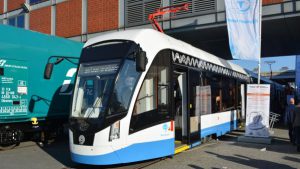
Mr Aleksandr Lvov of PCTS told IRJ that the company is seeking international customers, particularly in Europe.
In addition to Lion, PCTS also showed its new single-section 71-911EM Lionet low-floor tram at InnoTrans.
Tram safety set to benefit from Artificial Intelligence
A passive assistance system for trams which uses artificial intelligence to reduce the risk of collisions was unveiled by ZF.
The ZF ProAI central computer is capable of deep learning, with the system able to recognise and highlight potentially dangerous situations at stations, when passengers are moving around the vehicle.
An algorithm-based safety function uses data from cameras, Lidar and radars to calculate a detailed image of the vehicle’s surroundings, enabling the driver to monitor an area within a 6m radius of the vehicle when starting from a station. The system automatically recognises hazards and alerts the driver via the DMI screen.
Spoked wheel to reduce mass and wear
A prominent feature on the Shift2Rail stand was a prototype Austempered Ductile Iron (ADI) spoked wheel.
ADI is a cast material which offers a combination of strength, ductility and high wear resistance.
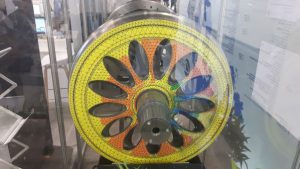
The aim of the TD 1.4 Running Gear project is to reduce wheel and rail wear, lower noise emissions and cut wheel mass by 10%.
Fatigue testing of four wheels has been carried out on a test bench and the wheel will be tested in service on the Nuremberg U-Bahn for at least a year to gather data on wear characteristics in real operating conditions.
Flirt UK bi-mode multiple unit unveiled
STADLER and British train operator Abellio Greater Anglia unveiled the bi-mode regional variant of the Flirt UK multiple unit at InnoTrans.
Stadler was awarded a £610m contract in October 2016 to supply 58 Flirt UK sets in regional (class 755) and inter-city (class 745) variants.
Stadler expects to deliver the first train to Britain in late October and the class 755 fleet will enter commercial service on regional routes in Essex, Suffolk, Norfolk and Cambridgeshire in May 2019.
“The benefits of these new trains for our customers, communities and staff will be huge,” says Greater Anglia managing director, Mr Jamie Burles. “The delivery of new trains underpins our plans for better timetables and better frequencies. This really is a massive upgrade for the railways of East Anglia. We’re putting inter-city quality trains onto regional routes and our customers won’t believe the step-change in quality.”
Vossloh shows flexible milling application
AMONG the new products on display at the Vossloh stand was the Multi Purpose Milling machine, which is designed to offer high levels of flexibility to support a wide range of milling applications, including conventional tracks, turnouts, and frogs.
The machine weighs 10 tonnes and at 5.8m in length, 2.2m high and 2.2m wide, it is suitable for transport in a standard container. The machine is also able to work on track gauges ranging from 1000mm to 1668mm as well as grooved tracks used on light rail networks, and is suitable for narrow profile infrastructure. The milling wheel has a diameter of 360mm and a cutting depth of up to 2mm while the machine can cover 180-280m/h during operation.
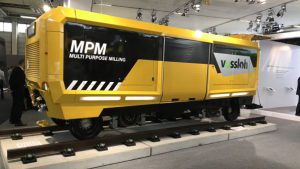
The absence of a driver’s cab reflects Vossloh’s desire to keep use as cheap as possible with the machine remote-control operated. Vossloh says automation is a possible area for further development and is beginning the certification process with light rail networks in Germany, which the supplier hopes to complete in the next six months.
- Vossloh also displayed the concept for a new composite sleeper, which is made from entirely recycled materials and includes a steel reinforcement which can be altered depending on the stiffness required.
Vossloh says the sleeper will offer a lower thermal expansion coefficient than conventional materials and plans to begin a six-month trial on a 2km section of a US Class 1 railway from December.
Here the sleepers will be monitored for performance when working with 36-tonne axleloads. Vossloh is also exploring the possibility of testing the sleepers in Germany.
Intermodal innovation gets non-cranable trailers on trains
TX Logistik, the German subsidiary of Italian rail freight operator Mercitalia, demonstrated an innovative low-cost system for lifting non-cranable lorry trailers onto trains at the outside area.
The NiKrasa system enables transfers to take place within existing standards and infrastructure and without any changes to the wagon, the semitrailer or business processes, eliminating the need to invest in existing transhipment facilities.
NiKrasa is already in use at terminals in Padborg, Denmark, Bettembourg, Luxembourg, and Verona and Trieste in Italy.
TXLogistik has 100 of the first-generation NiKrasa platforms in use as well as 50 of the 2.275-tonne second-generation version, which was on show at InnoTrans mounted on a Sdggmrss (T3000E) twin-unit articulated intermodal wagon built by Tatravagonka Poprad. The wagon is equipped with PJM telematics for automatic load, axlebox, running gear and location monitoring as well as Lucchini 23.5-tonne axleload wheelsets.
According to Mr Norbert Rekers, TX Logistik regional sales manager for central Europe, handling equipment can be installed in a terminal in three weeks and staff training can be completed in a day.
Siemens shows off driverless tram technology: Siemens hosted live trials of a driverless Combino LRV in Potsdam during the show. The trial run took place on a 6km section of lines 92 and 96 on the Potsdam network.
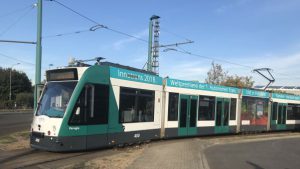
Potsdam Transport Auhority (VIP) CEO, Oliver Glaser, told IRJ that the next stage of the project is to use the autonomous technology at its depot and maintenance facilities to speed up operations. He added that VIP is keen to explore the technology ahead of its fleet replacement in 2020-22 and he expects driverless LRVs to take to the network in the late 2020s/early 2030s “when there is greater public acceptance of such autonomous technologies.”
In brief
ABB
Resibloc Rail, an oil-free traction transformer, which offers energy efficiency of 97%, was a highlight exhibit for ABB. The transformer reduces energy costs by 10% compared with traditional transformers and can cut carbon dioxide emissions by 38 tonnes per year. ABB launched the project in 2010 and a transformer has performed tests totalling 20 million km with SBB in Austria and Switzerland.
Alpha Trains
The CEO of European rolling stock leasing company Alpha Trains, Mr Shaun Mills, says he expects the Luxembourg Rail Protocol to deliver more competitive prices for vehicle leasing. By introducing a globally-enforceable security interest for creditors and lessors - similar to the system already in place in the aviation industry - the protocol is expected to create greater security for creditors when it comes into effect next year.
Continental
Continental is looking to broaden dialogue with the railway industry to find ways to exploit the expertise of its engineers currently working in other industries such as automotive and industrial areas, says the regional head of Continental railway initiative, Mr Bernhard Kassens. The company has also made developments in air spring systems, which meet new fire safety standards.
GE Transportation
GE unveiled a new lightweight high-speed diesel engine, which will make its debut on a new fleet of 300 shunting locomotives due for delivery to Kazakhstan Railways (KTZ) from 2019 onwards. The engine is expected to offer a 5% reduction in lifecycle costs, a 5% improvement in fuel efficiency, and a 10% reduction in maintenance costs.
GoMedia
As well as providing up-to-date news and onboard content from renowned broadcasters, British supplier GoMedia’s, onboard entertainment platform is set to offer real-time network and passenger updates from the end of 2018. GoMedia’s content is accessible via an online portal via the train’s Wi-Fi connection. Passengers will be able to check live delay information, station and airport connections and book
a taxi to continue their journey.
Harting
The German supplier showed its new reduced size and lightweight Ethernet cable. 1km of the Single Twister Pair cable weighs 30kg, compared with 45kg for conventional Ethernet cable, while still transmitting at 10GB a second. Harting has also focused on the miniaturisation and modulation of its connectors, with plastic housings reducing both weight and space to allow more functions in a smaller space while retaining interoperability with aluminium housings.
Lucchini
Italian wheelset manufacturer Lucchini presented the 11th guide in its technical series, which aims to show the benefits of thermostable wheels due to both the wheel’s technical and engineering strengths as well as enhanced life cycle costs. The book analyses tread-braked wheels and includes a special focus on the company’s Sura wheel.
Progress Rail
Progress Rail gave live demonstrations of its augmented reality system which is based on Cave automatic virtual environment technology. The system can optimise the locomotive design to meet customer needs or aid locomotive maintenance.
Ruf
Ruf showed a new app from its VisiWeb neo PIS platform, which allows conductors to control passenger information screens direct from a smartphone. The app can activate pre-set messages, such as “train delayed” or “please do not enter” and support the creation of customised messages for display on the inside and outside of the train. Conductors and drivers can also record and play audio messages throughout the train, or in individual sections.
Schaeffler
Schaeffler and Perpetuum signed a letter of intent to cooperate on developing the technology to support predictive maintenance. Schaeffler has also begun working towards a new purchase method, a mileage-based payment model for axlebox bearings with the goal of delivering significantly longer maintenance intervals and reduced operating costs.
Seoul Metro
The urban rail operator demonstrated its Smart Automatic Big Data Analysis System (Samba), a condition-based failure prediction solution. Using a real-time database, Samba stores and processes IoT and sensor data and uses configurable failure prediction algorithms to detect anomalies and predict where component failures may occur.
Talgo
Talgo showed for the first time a model of its new Avril ES high-speed train, 30 of which it is supplying to Renfe. The series 106 TSI-compatible trains will have a maximum design speed of 360km/h and a commercial speed of 330km/h. The first train will be ready for testing in late 2019 and will enter service in 2020. The 200m-long trains will have a power car at each end and will accommodate 521 passengers. The first 10 trains will be able to run in France.
Thermo-King
The supplier presented its new HVAC system, which uses R134A coolant, a lower Global Warming Potential (GWP) refrigerant, and retains the same performance, reliability and passenger comfort as current coolants, but with a reduced GWP of more than half. The new refrigerant can be used in current HVAC units using R134a.
ThermOmegaTech
The American supplier is continuing to develop self-actuated temperature control valves and signed a $US 80,000 contract with Amtrak at InnoTrans. While traditionally focused on freeze protection for locomotives, a similar valve for passenger coaches is now available.
Voestalpine
Using open data on track position and topography as well as feedback from more than 100 track tests compiled with customers over 15 years, Voestalpine’s track lifecycle measurement tool is able to compare the performance of different steel grades on specific track sections. The tool considers curve variations ranging from less than 300m to 700m, 1500m, 3000m and more than 3000m and shows the life cycle cost, and potential savings of using different steels as well as the capital value, annual CO2 emissions and the amortisation break-even point. The data can be adjusted depending on traffic volumes.
Vossloh
The German supplier is targeting the Italian market with its DE 18 smart hybrid shunting locomotive which was on display at InnoTrans, and which is due to start certification next year. The company is also developing the DE 20 concept locomotive, for which it is currently seeking a launch partner, as well as a predictive maintenance system.
Willow and Strukton
Willow and Strukton Build unveiled the “Willow Rail powered by Strukton” platform, which creates a digital twin of a line, providing valuable predictive, actionable insight into operations including passenger transport and supply chain. Strukton also announced a partnership with Siemens to develop an application that uses video recognition to automatically recognise track malfunctions before they occur. In addition, Strukton is partnering with Rail Restore to use water jet technology to treat small rail defects.
